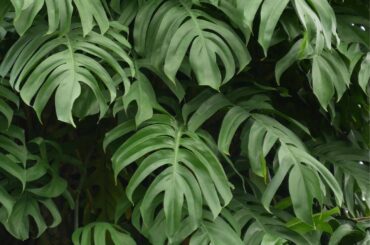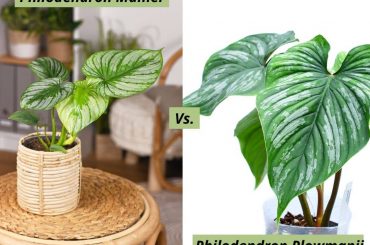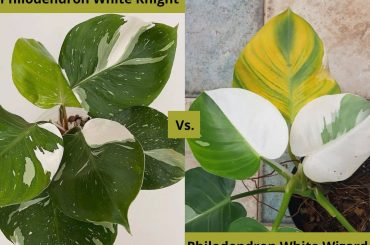Philodendron Lemon Lime vs. Moonlight are similar-looking tropical plants with relatively similar care requirements. Despite being in the same genus, Philodendron Lemon Lime and Moonlight have some essential differences that you should know before deciding which plant to buy.
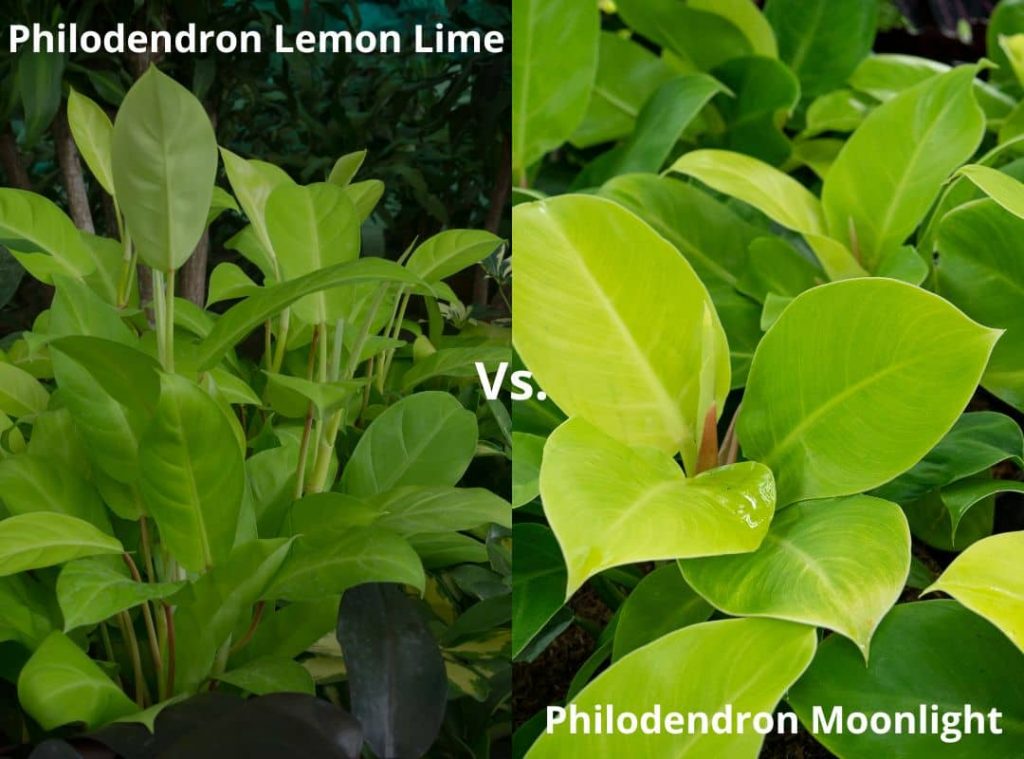
The most significant difference is the shape of foliage in both plants. The Lemon Lime leaves are paler and heart-shaped, while the Moonlight leaves are brighter and elongated. Further, the moonlight plant itself is wider than the Lemon Lime. Another significant difference is that Lemon Lime is a vine while Moonlight is not. This means that Lemon Lime will need some kind of support to grow while Moonlight can stand on its own.
In terms of care, both plants need well-draining soil and should be fertilized regularly during the growing season. You should also protect them from direct sunlight, as this can scorch the leaves. Despite these main differences, there are some more differences and similarities between these two plants. In this article, we’ll compare and contrast these two plants so that you can make a more informed decision.
| Plant Name | Philodendron Lemon Lime | Philodendron Moonlight |
| Type | Tropical | Tropical |
| Growth Rate | Fast | Fast |
| Habit | Vine | Bush |
| Usda Hardiness Zone | 10-11 | 10-11 |
| Mature Height | 20” (0.5 M) | 20” (0.5 M) |
| Mature Weight | 10” (0.25 M) | 20” (0.5 M) |
| Light Exposure | Indirect | Indirect |
| Watering | 1-2 Times Per Week | 1-2 Times Per Week |
| Soil | Airy, Well-Drained | Airy, Well-Drained |
| Soil Ph | 6.4-7.3 | 6.4-7.3 |
| Diseases | Fungus | Fungus |
| Pests | Insects | Insects |
Philodendron Lemon Lime Vs. Moonlight Differences
Origin
Philodendron Lemon Lime and Philodendron Moonlight are two varieties of Philodendron that have become popular houseplants in recent years. Lemon Lime was discovered as a spontaneous mutation in a laboratory in China. While the origin of Moonlight is unknown, it is thought to be a hybrid philodendron from Central and South America.
Growth Habit
Philodendron Lemon Lime is a climbing variety that clings to tree bark in the wild. It has a classic vining habit, growing upward and only slightly outwards. This variety is typically about 20 inches tall and only 10 inches wide because of their particular small leaves but can reach even greater heights in a larger pot.
Philodendron Moonlight, on the other hand, is a self-heading variety. Its central stem is short, lengthening only slightly each year. It has longer leaf stalks, which will sag under the weight of the leaves, resulting in a broader shrub. This variety is typically about 20 inches tall and 20 inches wide. As you can see, these two varieties have different growth habits. Philodendron Lemon Lime grows upward like a vine, while Philodendron Moonlight grows outward like a shrub. When selecting a philodendron for your house, you should think about how much space you own as well as how much maintenance you can do.
If you have a small space, Philodendron Lemon Lime may be a better option because it does not grow as wide. If you own extra space or are willing to do more maintenance, Philodendron Moonlight may be a better option because it is fuller and has more leaves.
Foliage Color
The Philodendron Lemon Lime and the Philodendron Moonlight are both beautiful plants that feature brightly colored foliage. The Lemon Lime has young leaves that are yellow with a hint of pink, which eventually turns to a lemon yellow color. This lemon yellow color eventually changes to lime green, but it will be less bright than the Moonlight. The Moonlight also has young yellow leaves without a pink hue, but they darken to a bright green as the plant matures. So, as you see, matured moonlight foliage is brighter than the Lemon Lime.
Mature Size
Philodendron Lemon Lime and Philodendron Moonlight are both versatile in terms of size. Philodendron Lemon Lime can range from 10 to 20 inches tall, while Philodendron Moonlight can range from 20 to 24 inches tall. Since Lemon Lime is a vine, it needs some kind of support, such as a trellis or pole, to reach its full height, while Moonlight can stand on its own.
In terms of width, Moonlight is wider than Lemon Lime because of its larger foliages. The leaves of Moonlight are 10 inches long and about 5 inches wide. They are attached to long petioles, giving them a longer appearance.
On the other hand, Lemon Lime has leaves that are 6 to 8 inches long and 5 to 6 inches wide. Also, the petioles are short but attached to a long stem. It also has a slightly larger number of leaves than Moonlight. But, the leaf size of Moonlight makes it look fuller than the Lemon Lime.
Pruning
Since these plants have different growth habits, they require different types of pruning. Like many other vining plants, Lemon Lime can grow quite tall, making it necessary to shorten the plant to keep it compact periodically. The best time to do this is in the spring when new growth is just beginning
When pruning Lemon Lime, be sure to use a sharp, sterile tool to avoid infection. Wounds should also be kept clean and dry; you can use hydrogen peroxide to help speed up the healing process. On the other hand, Moonlight grows slowly and does not need to be shortened. Prophylactic pruning, however, is still necessary to remove old leaves and encourage new growth. You should also remove diseased or yellowed leaves immediately.
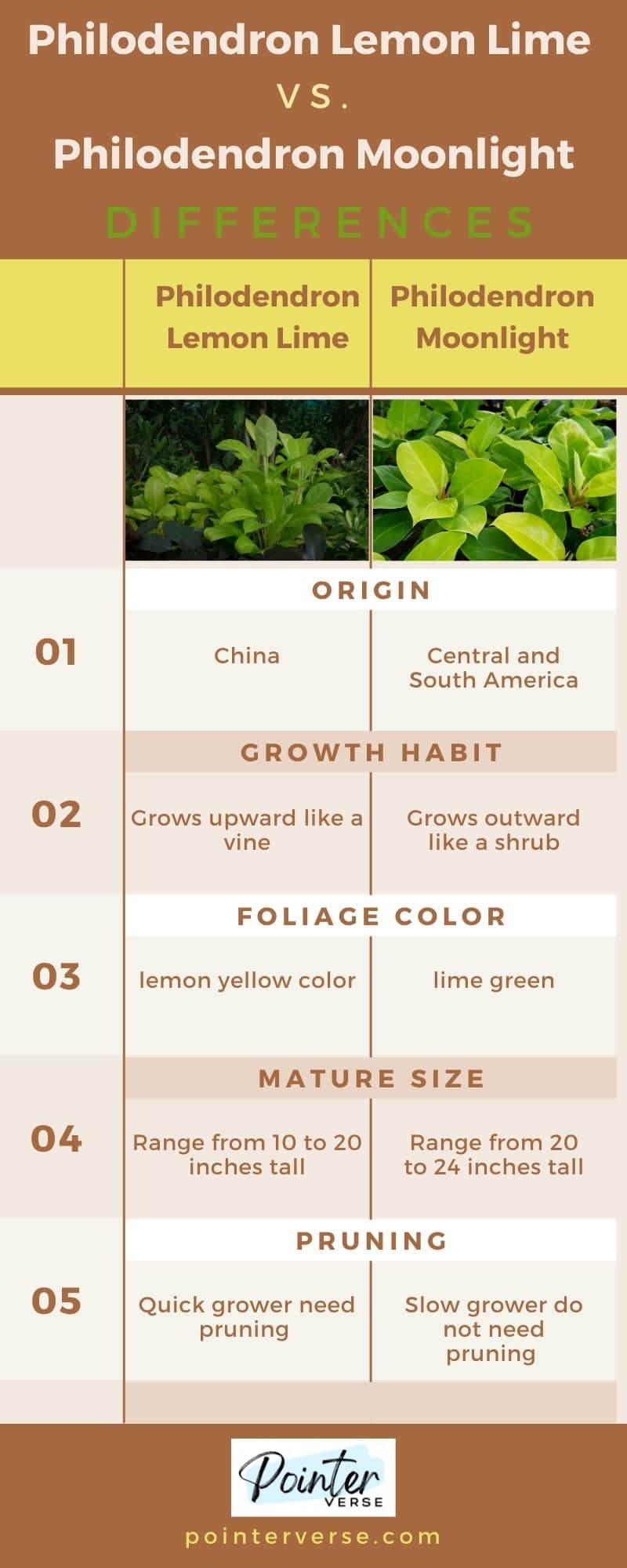
Philodendron Lemon Lime Vs. Moonlight Similarities
Since Lemon Lime and Moonlight share the same genus, they also share similarities. Most of the similarities refer to the maintenance of the plant, which is essential to know no matter what type of Philodendron plant you have. In general, both Philodendron Lemon Lime and Moonlight are easy to care for and are low-maintenance plants.
Light Requirement
In the wild, philodendrons grow under large trees with minimum sunlight. The trees filter out the harsh sun rays, which is why philodendrons do not need direct sunlight to survive. In terms of light requirements, both Philodendron Lemon Lime and Moonlight need indirect light. If the leaves start to turn yellow, that is an indication that the plant is getting too much light. On the other hand, if the foliage is pale green or has brown spots, that means the plant is not getting enough light.
The ideal location for these plants would be near an east- or west-facing window. Alternatively, you can grow both plants indoors with an artificial light source, such as a fluorescent light.
Watering
Both Philodendron Lemon Lime and Moonlight should be watered regularly to keep the soil moist but not soggy in the summer. The watering frequency will depend on the pot size, the type of soil, and the temperature and humidity of the room.
In the winter, however, you should water the plants less frequently to allow the soil to dry out slightly between watering. Because philodendrons are susceptible to root rot, overwatering is a regular concern. Allow the soil to dry fully before watering again if you suspect you are overwatering your plant.
It is also critical to use a well-draining pot to prevent the roots from sitting in water. The signs of root rot are yellowing of leaves, wilting, and brown spots.
Fertilizing
Philodendrons are not heavy feeders, so they do not need to be fertilized often. A general-purpose fertilizer should be applied every two to four weeks during the growing season, which is from spring to fall. The plants will not actively grow in the winter. So, you can reduce fertilizer to once a month or every six weeks during this time. You should use a fertilizer that is designed explicitly for philodendrons, as they are sensitive to chemicals. Alternatively, you can use an all-purpose NPK formula for both plants.
Temperature Requirement
Philodendrons are tropical plants, so they like warm temperatures. The ideal temperature range for both Philodendron Lemon Lime and Moonlight is between 70 and 75 degrees Fahrenheit.
The plants will become stressed if the temperature falls below 60 degrees Fahrenheit. The plants will begin to perish if the temperature falls below 50 degrees Fahrenheit. Therefore, it is important to keep both plants indoors during the winter if you live in a cold climate. Extreme heat is another potential problem. If the temperature levels are too high and the plant is not sufficiently watered, it can enter into a state of stagnation.
Humidity
Philodendrons also like humid environments. The ideal humidity range for Philodendron Lemon Lime and Moonlight is about 70% to 80%. At ideal humidity levels, the plant will have larger leaves and look more healthy.
If the environment is excessively dry, sprinkle the leaves with water or place the pot on a pebble tray to promote humidity. A pebble tray is a small tray filled with pebbles or stones and filled with water. The evaporation of the water raises the humidity around the plant.
Soil Type
Philodendrons prefer light and airy soil that is well-draining. A good potting mix for both Philodendron Lemon Lime and Moonlight would be a mixture of peat moss, perlite, and vermiculite. You can also use compost or coco coir as a light and airy alternative to the potting mix.
Pests and Diseases
Philodendrons are generally resistant to pests and diseases but can occasionally be affected by mealybugs, aphids, or spider mites. Mealybugs are small, white pests that love to feast on the sap of plants. They can cause yellowing of leaves and stunted growth.
Aphids are small, green pests that feed on the sap of plants. They can cause yellowing of leaves and stunted growth. Spider mites are small, red pests that feed on the sap of plants. They can cause yellowing of leaves and stunted growth. Keeping the leaves clean and dry is important to prevent pests and diseases from affecting your plants. You can also use a pesticide or insecticide to kill or repel pests.
If your plant is affected by a pest or disease, you can try to remove the affected leaves or stems. You can also use pesticides or insecticides to kill or repel the pests. You should moisten the leaves with water and apply an acaricide solution to combat the spider mites.
Toxicity
Both Philodendron Lemon Lime and Moonlight are poisonous to humans and animals if ingested. The Philodendron plants contain calcium oxalate, which can cause burning and irritation of the mouth and throat, vomiting, and difficulty swallowing. If ingested in large quantities, the calcium oxalate can cause kidney damage.
Therefore, keeping both plants out of reach of children and pets is important. If you think that your child or pet has ingested a philodendron, you should seek medical attention immediately.
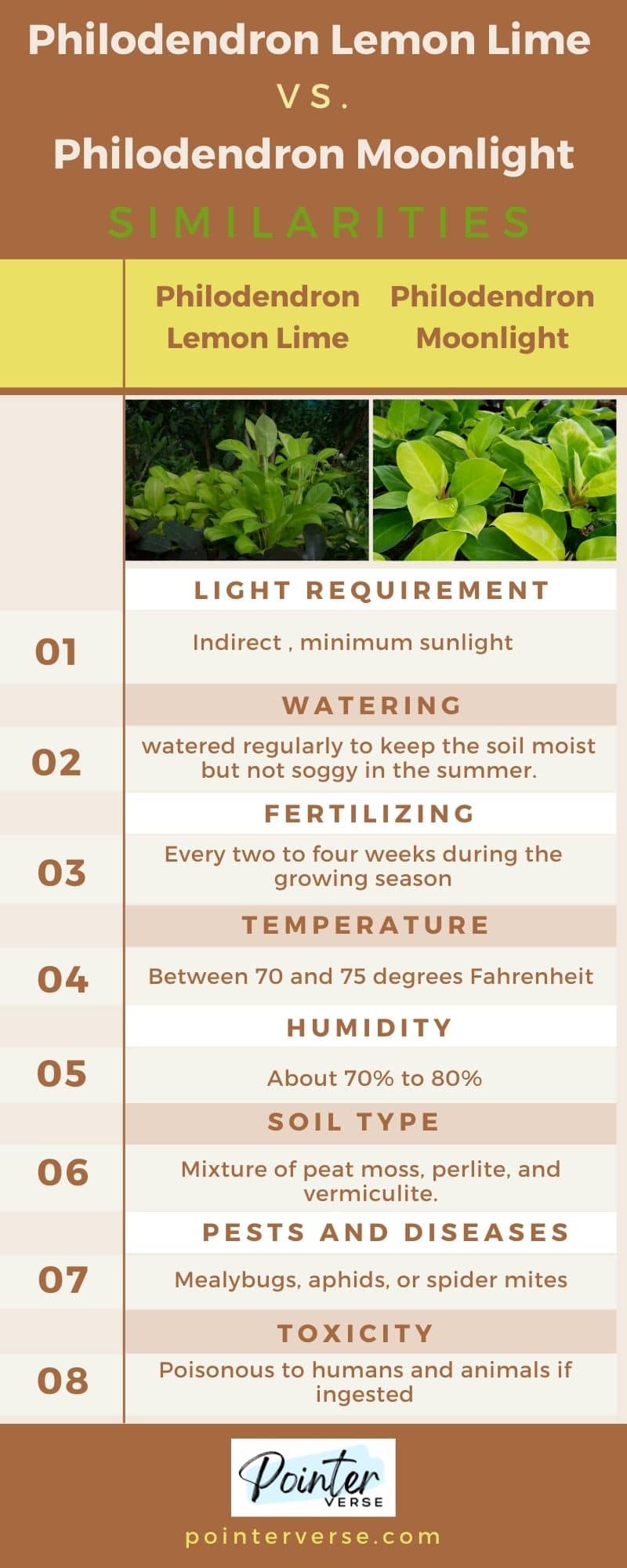
Conclusion: Philodendron Lemon Lime Vs. Moonlight
Both Philodendron Lemon Lime and Moonlight are great plants that can add beauty and color to your home. They are easy to care for and are resistant to most pests and diseases. However, Philodendron Lemon Lime is a better choice if you are looking for a plant that tanks less space. It is also a better choice if you want a plant that can tolerate lower humidity levels.
Philodendron Moonlight is a better choice if you are looking for a plant that can tolerate higher humidity levels. It is also a good choice if you want a plant with larger leaves. Both plants are toxic to humans and animals if ingested, so it is important to keep them out of reach of children and pets.
Read Next : Do Elephant Ears Come Back Every Year ?


